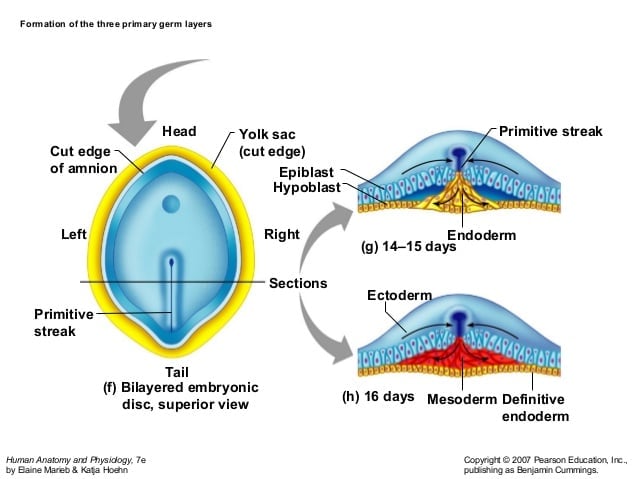- The most characteristic event occurring during the third week of gestation is gastrulation.
- Gastrulation is a formative process by which the three germ layers, which are precursors of all embryonic tissues, and the axial orientation are established in embryos.
- During gastrulation, the bilaminar embryonic disc is converted into a trilaminar embryonic disc.
- Extensive cell shape changes, rearrangement, movement, and alterations in adhesive properties contribute to the process of gastrulation.
- The embryo during this stage is called a gastrula.

Image Source: Pearson Education
Interesting Science Videos
Process of Gastrulation
- Gastrulation begins with the formation of the primitive streak on the surface of the epiblast.
- Initially, the streak is vaguely defined, but in a 15- to a 16-day embryo, it is clearly visible as a narrow groove with slightly bulging regions on either side.
- The cephalic end of the streak, the primitive node, consists of a slightly elevated area surrounding the small primitive pit.
- Cells of the epiblast migrate toward the primitive streak.
- Upon arrival in the region of the streak, they become fl ask-shaped, detach from the epiblast, and slip beneath it. This inward movement is known as invagination.
- Once the cells have invaginated, some displace the hypoblast, creating the embryonic endoderm, and others come to lie between the epiblast and newly created endoderm to form mesoderm.
- Cells remaining in the epiblast then form ectoderm.
- Thus, the epiblast, through the process of gastrulation, is the source of all of the germ layers, and cells in these layers will give rise to all of the tissues and organs in the embryo.
Each of the three germ layers (ectoderm, mesoderm, and endoderm) gives rise to specific tissues and organs:
- Embryonic ectoderm gives rise to the epidermis, central and peripheral nervous systems, eyes and internal ears, neural crest cells, and many connective tissues of the head.
- Embryonic endoderm is the source of the epithelial linings of the respiratory and alimentary (digestive) tracts, including the glands opening into the gastrointestinal tract, and glandular cells of associated organs such as the liver and pancreas.
- Embryonic mesoderm gives rise to all skeletal muscles, blood cells, the lining of blood vessels, all visceral smooth muscular coats, serosal linings of all body cavities, ducts and organs of the reproductive and excretory systems, and most of the cardiovascular system. In the body (trunk or torso), excluding the head and limbs, it is the source of all connective tissues, including cartilage, bones, tendons, ligaments, dermis, and stroma (connective tissue) of internal organs.
Factors controlling the process of Gastrulation
- Cell migration and specific cation are controlled by fibroblast growth factor 8 (FGF8), which is synthesized by streak cells themselves.
- This growth factor controls cell movement by downregulating E-cadherin, a protein that normally binds epiblast cells together.
- FGF8 then controls cell specific cation into the mesoderm by regulating Brachyury (T) expression.
Consequences
Gastrulation results in three important outcomes:
- The formation of the embryonic tissues called germ layers. The germ layers include the endoderm, ectoderm, and mesoderm. Each germ layer will later differentiate into different tissues and organ systems.
- The formation of the embryonic gut or archenteron.
- Gastrulation is the beginning of morphogenesis (development of body form).
- The appearance of the major body axes.
References
- Gilbert, S. F. (2000). Developmental biology. Sunderland, Mass: Sinauer Associates.
- Schoenwolf, G.C., Bleyl, S.B., Brauer, P.R., Francis-West, P.H. & Philippa H. (2015). Larsen’s human embryology (5th ed.). New York; Edinburgh: Churchill Livingstone.
- Sadler, T. W., & Langman, J. (2004). Langman’s medical embryology. Philadelphia, Pa: Lippincott Williams & Wilkins.
- Moore, K. L., Persaud, T. V. N., & Torchia, M. G. (2008). The developing human: Clinically oriented embryology. Philadelphia, PA: Saunders/Elsevier.
- http://bio1520.biology.gatech.edu/growth-and-reproduction/animal-development-ii/

So helpful
The content is simplified and well explained.